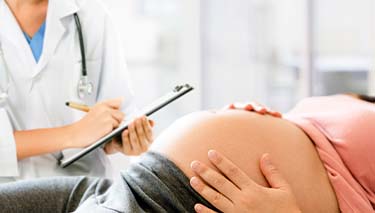Pregnancy related pain in the region of the symphysis pubis accounts for a great deal of discomfort for many women. When the bones which form the front of the pelvis become unstable and move, then the associated bone and nerve pain can, and does impact on normal, everyday mobility. Which is why pregnant women with Symphysis Pubis Dysfunction (SPD) are often desperate to know what causes this condition and what they can do to relieve their symptoms.
The first thing to remind yourself of is that you are not alone. It's estimated that around 1 in every 300 women will experience some degree of SPD. Many health care professionals consider the incidence is actually higher than this, though not all women are formally diagnosed. Women commonly put their discomfort down to one of those things or general pregnancy discomfort when in fact, it is a condition which responds very well to correct management.
Because SPD symptoms can build up gradually, it can be difficult to pinpoint exactly how much discomfort is due to the condition. It can pay to invest some time and thought into focusing on particular areas which are causing problems.
What are the Symptoms of Symphysis Pubis Dysfunction?
- A sharp and sometimes overwhelming pain in the region at the front of the pubic area.
- Stabbing, shooting, or a burning type of pain which can also be felt into the hip bones, the back, the perineum and the backs of the legs.
- A waddling walking gait.
- Knee pain which may extend down to the ankles and the feet. This is generally a result of alignment problems further up in the pelvis.
- When lifting one leg in front of the other or when standing on one leg e.g. when climbing stairs, getting out of bed or twisting, the pain can be felt more acutely.
- Often the pain is worse at night when lying on the back. Turning over in bed and lifting the legs to get out of bed can exacerbate the pain.
- A grating, clicking or grinding noise may be heard or even felt in the region of the pubic bone.
- Difficulty walking especially after standing still for a period of time.
- Some women experience urinary incontinence.
What Increases the Risk of Getting Symphysis Pubis Dysfunction?
- Gaining an excessive amount of weight during pregnancy.
- Having a multiple pregnancy or a very large baby. Gestational diabetes can add to gestational weight gain and increase birth weight.
- Having an elevated basal metabolic rate BMI.
- Repeated jarring type exercises, strenuous activity, poor posture and previous injury all increase the likelihood of developing this condition.
- The position or lie of the baby can play a contributing role.
- The quality of an individual woman's connective tissue also affects the stability of her pelvis.
- Previous trauma or fracture to the pelvis.
What causes Symphysis Pubis Dysfunction?
The pelvic bones are generally kept stable and well supported by the ligaments which surround them. During pregnancy, hormones are released which are designed to relax the joints and help to facilitate an easier birth. However, these hormones can also make the pelvic joint unstable which leads to pain and discomfort. The specific area affected in SPD is the narrowest point of the bones in the pelvic girdle which lies directly in front of the bladder. The symphysis pubis is the region at the front of your pelvis which is normally covered by pubic hair.
Another contributing factor is the changes in weight distribution which create stress on the pelvis, the spine and all the structures which support them.
How is it Diagnosed?
Symphysis Pubis Dysfunction is diagnosed through taking a thorough medical history. Ultrasounds may help in the diagnosis as well. It is not advisable for pregnant women to have X-Rays unless absolutely warranted.
What is the Management of Symphysis Pubis Dysfunction?
Treatment is generally based around limiting movement which exacerbates the condition. Avoiding any movement which aggravates SPD can be difficult, especially when there are older children to care for. Adjusting work and sleeping areas can be helpful; so can asking for help with activities which have become painful. Obstetric physiotherapists and occupational therapists can provide expert advice and guidance on modifying work and rest areas.
Straddling movements are out when SPD has been diagnosed. Think about the position of the legs when sitting on a horse or riding a bike. It's the separation of the legs which causes problems. The key is to try to brace the pelvis to keep it stable before any movement and to keep the knees together so pelvic bones don t have a chance to rub against each other and cause pain.
What Can Really Help to Relieve the Pain
- Rigid or non-rigid pelvic support girdles/belts or corsets can provide a lot of relief. These help to support the bones of the pelvis back into their correct alignment. Corsets need to be custom fitted by a physiotherapist and adjusted as the abdomen enlarges. They may also need to be worn during sleep if the SPD pain is impacting on being able to sleep and stay comfortable in bed.
- Side sleeping can be helpful as long as the abdomen and upper leg are well supported by pillows. Full length body pillows can be very useful during pregnancy and are available from large department stores and specialty sleeping outlets.
- Avoid lying on the back during sex and instead, try lying on your side. Often SPD can be so uncomfortable that it makes sex impossible.
- Be careful when getting in and out of a car, moving in bed and doing any activity which requires one leg to be lifted independently rather than two together. Squeezing the knees together when moving rather than separating them is beneficial and helps to stabilise the pelvic joint.
- Pelvic floor exercise that focus and strengthen these muscles are generally helpful.
- Standing tall and concentrating on improving the posture also help.
- Use a pillow for lower back support when sitting. Keep a cushion in the car for when travelling. Make sure you have plenty of cushions and pillows on your bed and sitting areas so you are reminded to use them each time you sit.
- Speak with the workplace health and safety representative in your workplace and see if you are entitled to an ergonomic assessment. Long hours sitting in an unsupportive chair or creating further pelvic strain won t help.
- Avoid wearing high heels. Limiting heel height to no more than 3-4 cm is ideal. This helps to reduce the strain on the lower back.
- Avoiding sitting with the legs crossed, even when on the floor or instructed to do so during yoga.
- Avoid doing exercises which require a lot of bouncing, standing on one foot or jarring.
- Avoiding bike riding which can create further problems with opening the already unstable joint.
- For some women, acupuncture, massage and deep muscle relaxation exercises have been found to be helpful.
- Sometimes gentle treatment with an osteopath can be useful. Be cautious whenever following any complimentary or alternative medicine route. It is always wise to check with your health care provider to ensure there are no contraindications.
- Placing insulated icepacks over the tender area can help with swelling and pain. Just be cautious about not leaving them in for too long: 5-10 minutes every few hours is plenty.
- Analgesics are sometimes necessary though it is imperative that you speak with your health care provider or a pharmacist to ensure that the medication you plan to take is safe to ingest during pregnancy.
How Long will it Last?
Generally there is an improvement in symptoms and joint stability after birth. Once the pregnancy hormone relaxin is no longer produced, the joint becomes more stable and there is an improvement in comfort level.
Occasionally SPD is so severe that a vaginal delivery is not possible. In this case a caesarean section is performed.
Will I always have Problems?
This is unlikely. Some women experience ongoing problems with their back or pelvic floor following delivery but most recover very well. If you have had SPD with a previous pregnancy, you are more likely to have it again. There are real benefits in seeing a specialist obstetric physiotherapist if pain, discomfort or incontinence are present. Check The Australian Physiotherapy Website for more information and to find a physiotherapist for your needs.
Are there any Complications?
Occasionally, the pelvic joint may actually separate causing more intense pain. This is a condition known as symphyseal separation or diastasis of the symphysis pubis. This can be acutely painful. Bed rest and heat treatment are usually prescribed. Orthopaedic and physiotherapy assessment and management are necessary to help manage this condition. Some women are also advised to limit their weight bearing activity and need to walk with elbow crutches to alleviate further pain.
Additional Reading
Hold it Mama The Pelvic Floor & Core Handbook by Mary O Dwyer (2011) Redsok Publishing.
Also check
www.holditsister.com
Last Published* May, 2024
*Please note that the published date may not be the same as the date that the content was created and that information above may have changed since.





















